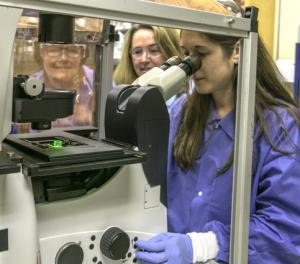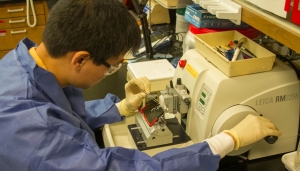LAB REPORT
Science and Technology Making Headlines
July 15, 2016

Changes in cloud patterns during the last three decades, which likely have had a warming effect on the planet, sync up with climate model simulations. Image courtesy of NASA Goddard Space Flight Center.
Cloudy outlook for climate change
In a new study, Lawrence Livermore scientists and collaborators say they have thoroughly documented one of the most profound planetary changes yet to be caused by a warming climate: The distribution of clouds all across the Earth has shifted.
And moreover, it has shifted in such a way — by expanding subtropical dry zones, located between around 20 and 30 degrees latitude in both hemispheres, and by raising cloud tops — as to make global warming worse.
The study is the first credible demonstration that the cloud changes expected from climate models and theory are actually happening.


Lawrence Livermore cybersecurity experts are part of a three-year grid modernization initiative.
Protecting the grid
Cybersecurity experts, including scientists from Lawrence Livermore, are leading a new program to develop new data analysis methods to better protect the nation’s power grid.
The goal is to develop technologies and methodologies to protect the grid from threats by developing the means to distinguish between power grid failures caused by cyberattacks and failures caused by other means, including natural disasters, “normal” equipment failures and even physical attacks.
The project, “Threat Detection and Response With Data Analytics,” is part of a $220 million, three-year Grid Modernization Initiative launched in January by the Department of Energy to support research and development in power grid modernization.


Lab scientist Heather Enright examines the "human-on-a-chip" device while Kris Kulp, left, and Elizabeth Wheeler observe.
Call it ‘mini human’
Lawrence Livermore scientists have been developing a microchip that is a miniature replication of the human body, in a project called iCHIP (in-vitro Chip-based Investigational Platform). It could replace animal testing.
The scientists take human cells or tissues and put them on microchips and test them with various drugs and toxins. They can then predict the reaction on the human body, which can also help speed up the development of medical countermeasures.
"Animal testing can be more complicated and costly, whereas these chips can be much more reliable," said Kris Kulp, an LLNL scientist who is part of the project.


A simulation shows how stars form from a cloud of gas.
A gassy start
A new supercomputer simulation has shown how stars and clusters form within filaments of gas over a period of 700,000 years.
The simulation is based on computer code created by Lawrence Livermore astrophysicist Richard Klein to capture the effects of radiation, magnetic fields, gravity and other physical phenomena, and paint a realistic portrait of star formation.
The evolution of a young star cluster beings with a giant cloud of interstellar gas and dust collapsing under the force of gravity. Turbulent clumps of gas form and then collapse inside the cloud. The collapsed clumps form star clusters, and then the magnetized, swirling cores further evolve to form individual or small groups of stars.


Jiun Chang, a UC Merced graduate student working at LLNL, studies cartilage degeneration in an anterior cruciate ligament (ACL) injury in a mouse model. The research will help doctors better treat the onset of arthritis after a high-impact injury. Photo by Julie Russell/LLNL.
Tracking the disease
Gene expression may impact the severity of arthritis pain and lead to developments in personalizing medical care for these patients, according to a recent study by Lawrence Livermore scientists.
The team studied 1,446 genes differentially expressed in injured joints in order to determine the cause of post-traumatic osteoarthritis from joint injury. These joints were observed at one day and one, six and 12 weeks after injury in mice models of ACL ruptures from a single high-impact injury.
The study provides insight into gene expression changes linked to post-traumatic osteoarthritis development and the progression in the ACL rupture animal model, the researchers explained. The researchers said their study is the first account of whole genome expression profiles to collect new information into the temporal progression of the disease.





